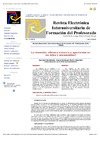Identificador persistente para citar o vincular este elemento:
https://accedacris.ulpgc.es/handle/10553/69579
| Campo DC | Valor | idioma |
|---|---|---|
| dc.contributor.author | Rodríguez Martín, Alejandro | en_US |
| dc.contributor.author | Escandell Bermúdez, María Olga | en_US |
| dc.date.accessioned | 2020-01-31T18:29:35Z | - |
| dc.date.available | 2020-01-31T18:29:35Z | - |
| dc.date.issued | 2002 | en_US |
| dc.identifier.issn | 1575-0965 | en_US |
| dc.identifier.other | Dialnet | - |
| dc.identifier.uri | https://accedacris.ulpgc.es/handle/10553/69579 | - |
| dc.description.abstract | La violencia en la sociedad y, en consecuencia, la indisciplina en las aulas se ha convertido en una preocupación para muchos docentes de nuestro país, para las familias que soportan a niños y jóvenes con alto grado de conflictividad, así como para el propio alumnado y la administración educativa. La conflictividad escolar es actualidad en muchos centros educativos y en bastantes hogares. Hay que entenderla como una desviación en el proceso de socialización normal del individuo; un proceso, marcado por los agentes de socialización, donde la televisión juega un papel básico a la hora de influir en los comportamientos de los niños y jóvenes, y en las repercusiones educativas y sociales de éstos | en_US |
| dc.description.abstract | The violence in the society and, consequently, the indiscipline in the classrooms has become a preoccupation for many educational ones of our country, the families who support to children and young people with high degree of confliction, as well as for the own pupils and the educative administration. The scholastic confliction is the present time in many educative centers and enough homes. It is necessary to understand it like a deviation in the process of normal socialization of the individual; a process, marked by the agents of socialization, where the television plays a basic role at the time of influencing in the behaviors of the children and young people, and in the educative and social repercussions of these. | en_US |
| dc.language | spa | en_US |
| dc.relation.ispartof | Revista electrónica interuniversitaria de formación del profesorado | en_US |
| dc.source | Revista electrónica interuniversitaria de formación del profesorado [ISSN 1575-0965],v. 5 (4), p. 6 | en_US |
| dc.subject | 63 Sociología | en_US |
| dc.subject.other | Violencia | en_US |
| dc.subject.other | Televisión | en_US |
| dc.subject.other | Agresividad en niños y adolescentes | en_US |
| dc.title | La televisión: ¿Genera violencia y agresividad en los niños y adolescentes? | en_US |
| dc.type | info:eu-repo/semantics/article | en_US |
| dc.type | Article | en_US |
| dc.identifier.url | http://dialnet.unirioja.es/servlet/articulo?codigo=1034349 | - |
| dc.description.lastpage | 6 | - |
| dc.identifier.issue | 4 | - |
| dc.description.firstpage | 6 | - |
| dc.relation.volume | 5 | - |
| dc.investigacion | Ciencias Sociales y Jurídicas | en_US |
| dc.type2 | Artículo | en_US |
| dc.contributor.authordialnetid | No ID | - |
| dc.contributor.authordialnetid | 751247 | - |
| dc.identifier.dialnet | 1034349ARTREV | - |
| dc.utils.revision | Sí | en_US |
| dc.identifier.ulpgc | Sí | es |
| dc.description.sellofecyt | Sello FECYT | |
| dc.description.esci | ESCI | |
| item.grantfulltext | open | - |
| item.fulltext | Con texto completo | - |
| crisitem.author.dept | GIR Sociedad Digital | - |
| crisitem.author.dept | Departamento de Psicología, Sociología y Trabajo Social | - |
| crisitem.author.orcid | 0000-0002-5228-5533 | - |
| crisitem.author.parentorg | Departamento de Psicología, Sociología y Trabajo Social | - |
| crisitem.author.fullName | Escandell Bermúdez, María Olga | - |
| Colección: | Artículos | |
Visitas
423
actualizado el 23-nov-2024
Descargas
208
actualizado el 23-nov-2024
Google ScholarTM
Verifica
Comparte
Exporta metadatos
Los elementos en ULPGC accedaCRIS están protegidos por derechos de autor con todos los derechos reservados, a menos que se indique lo contrario.
